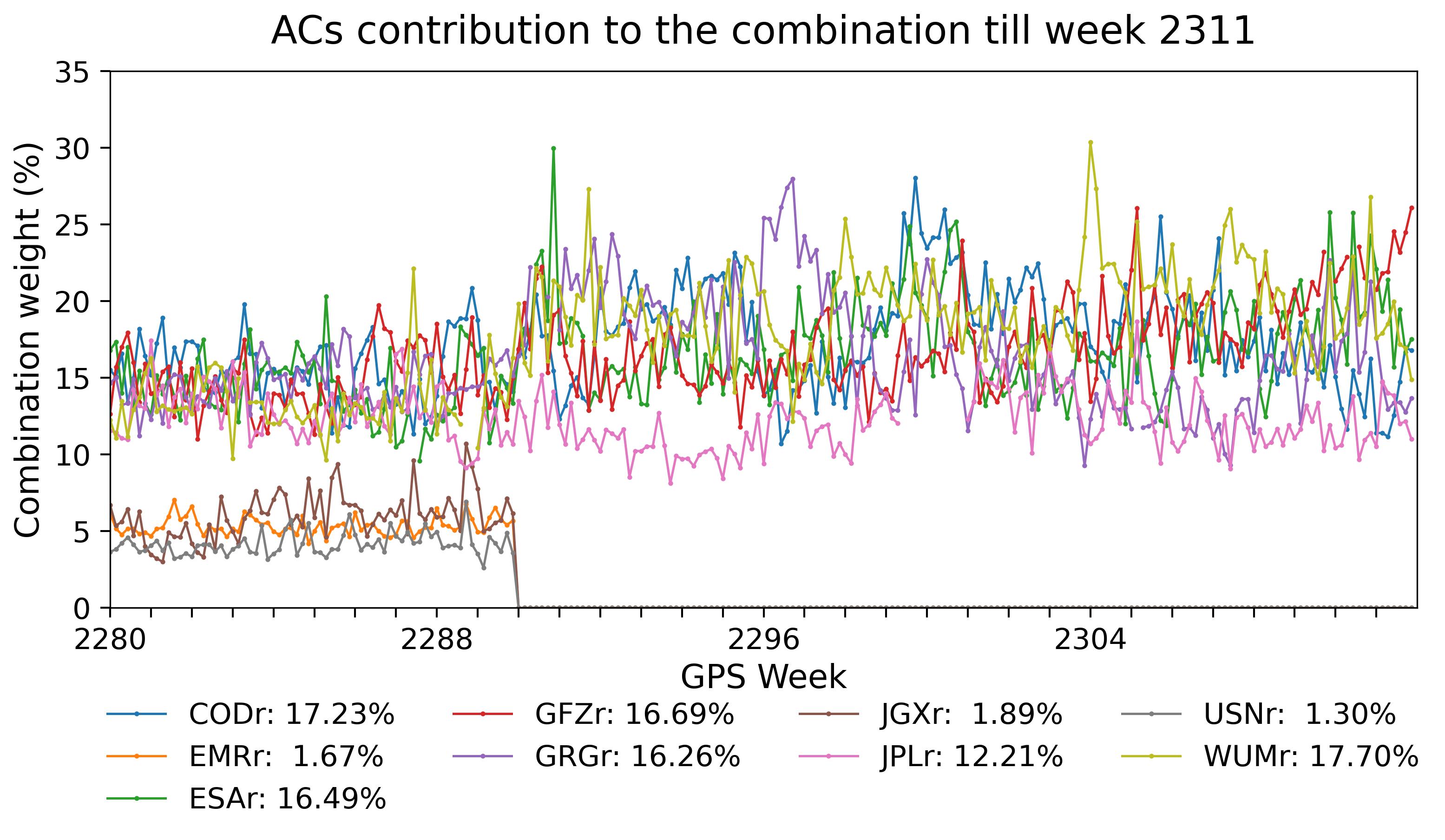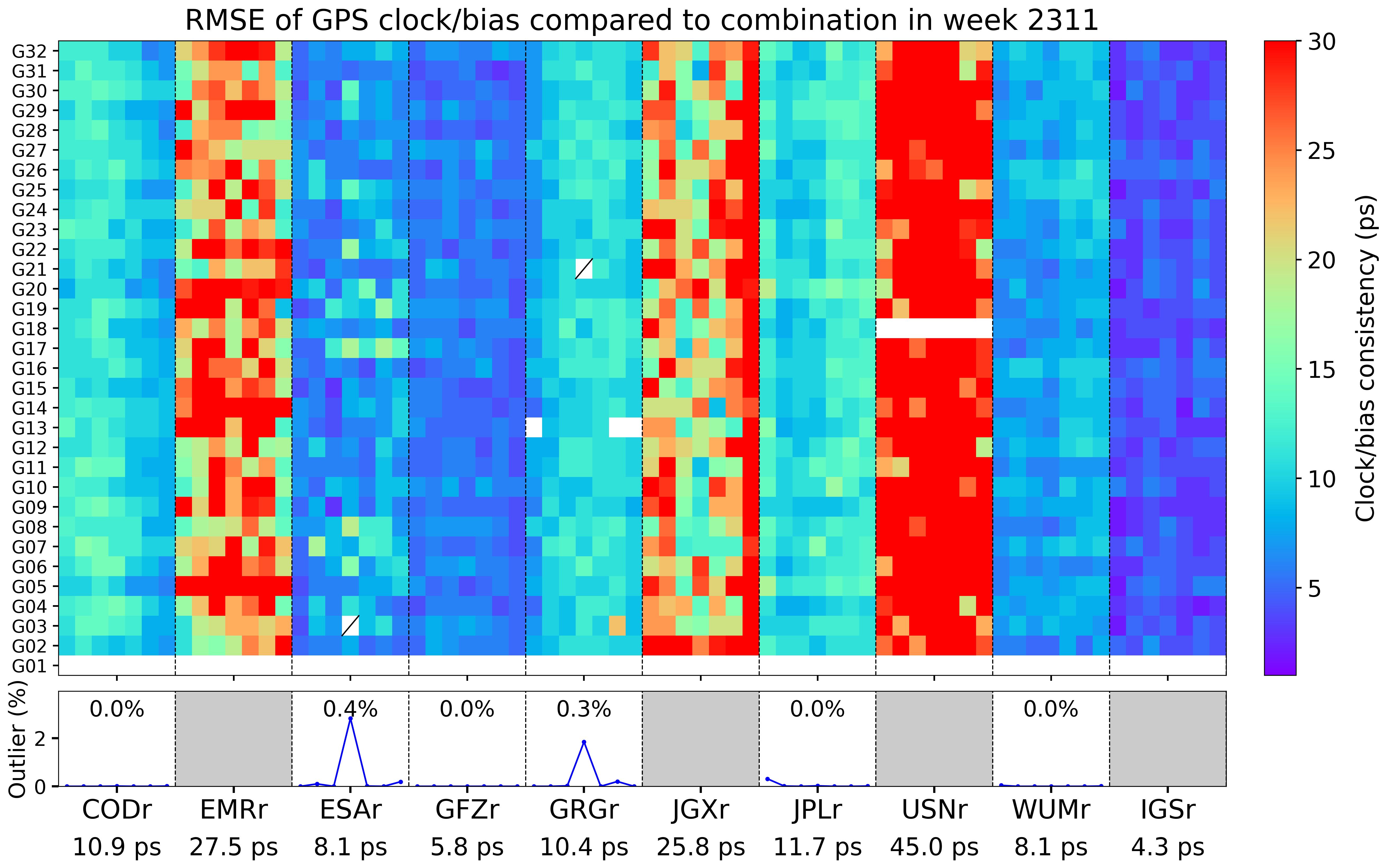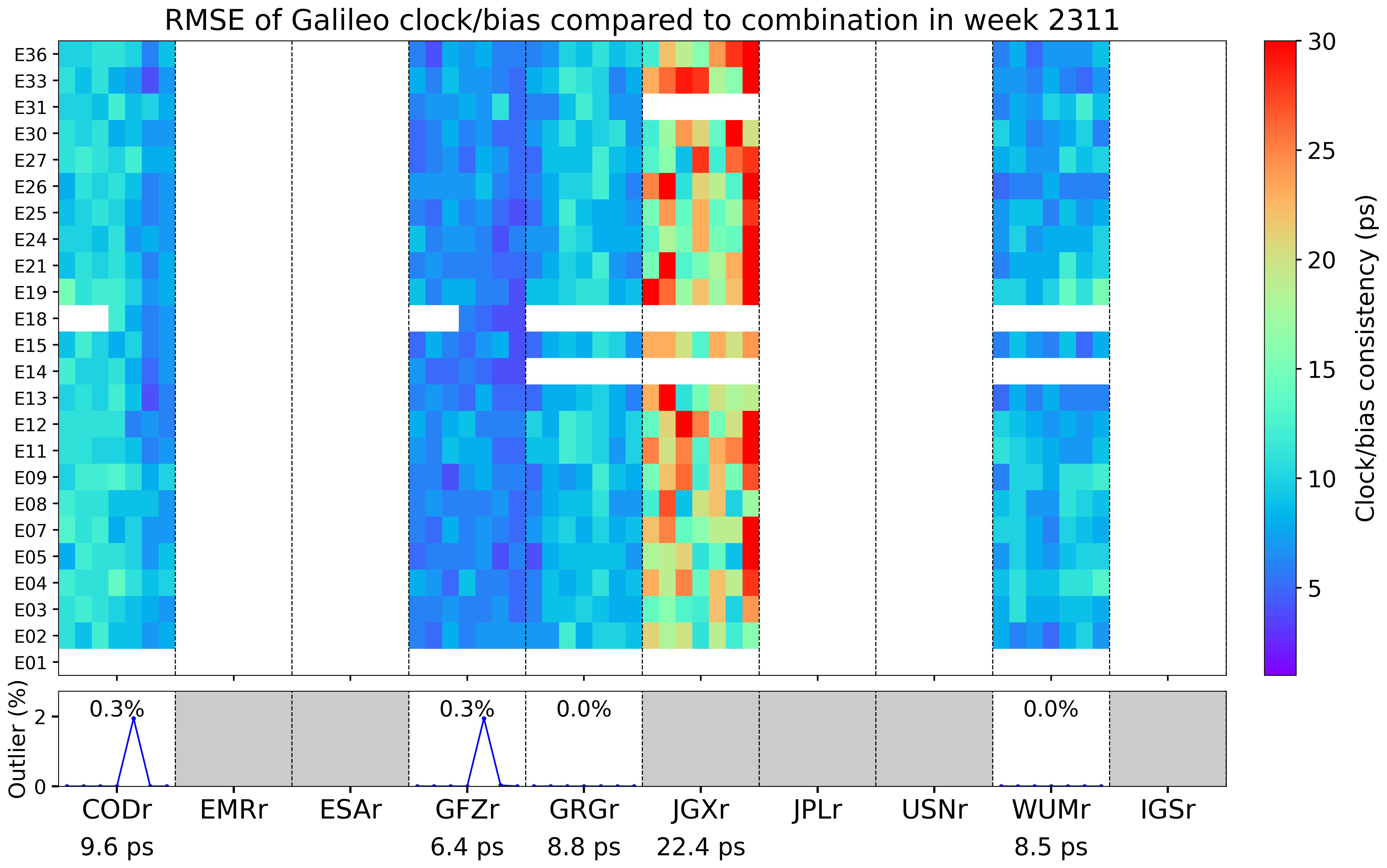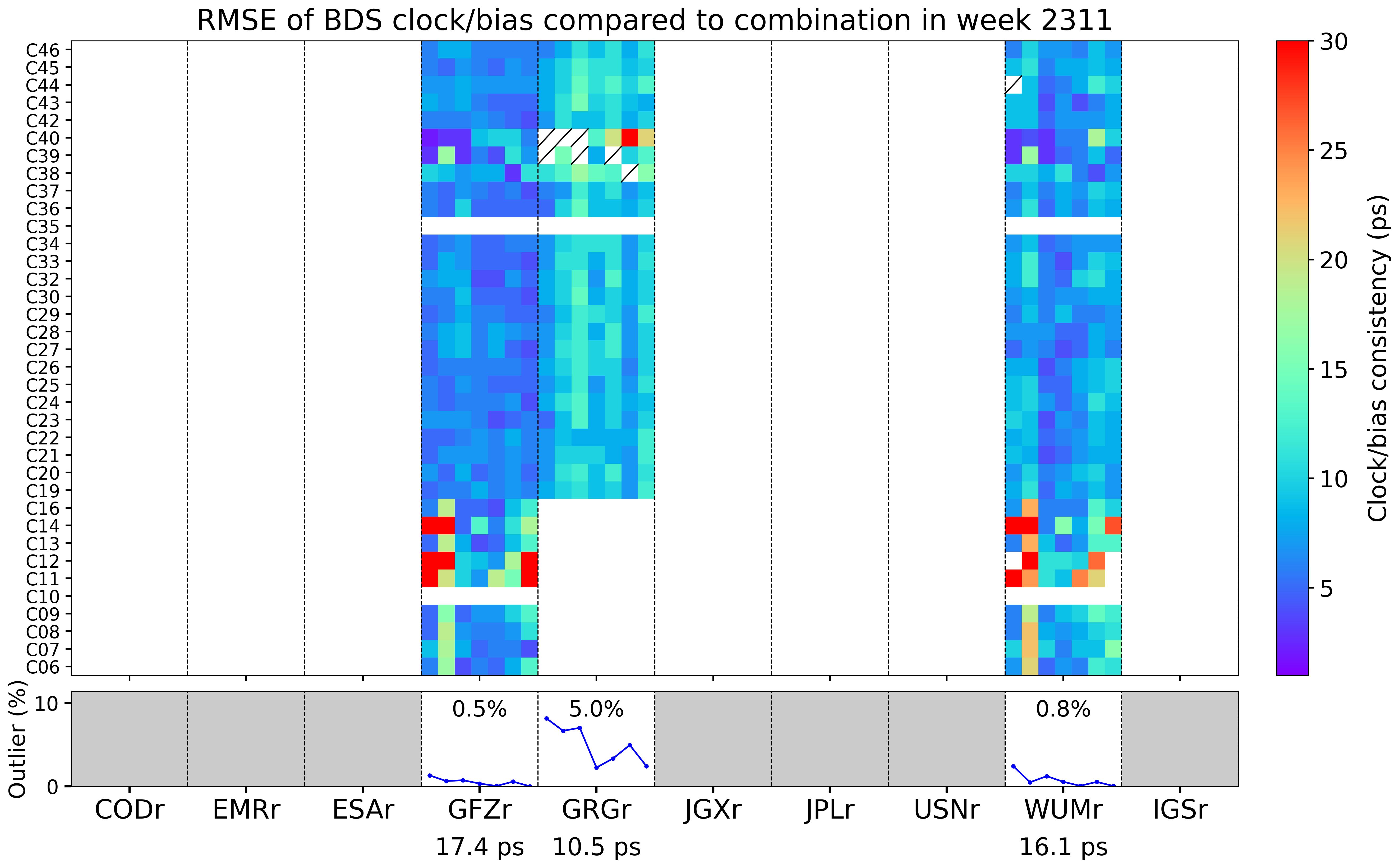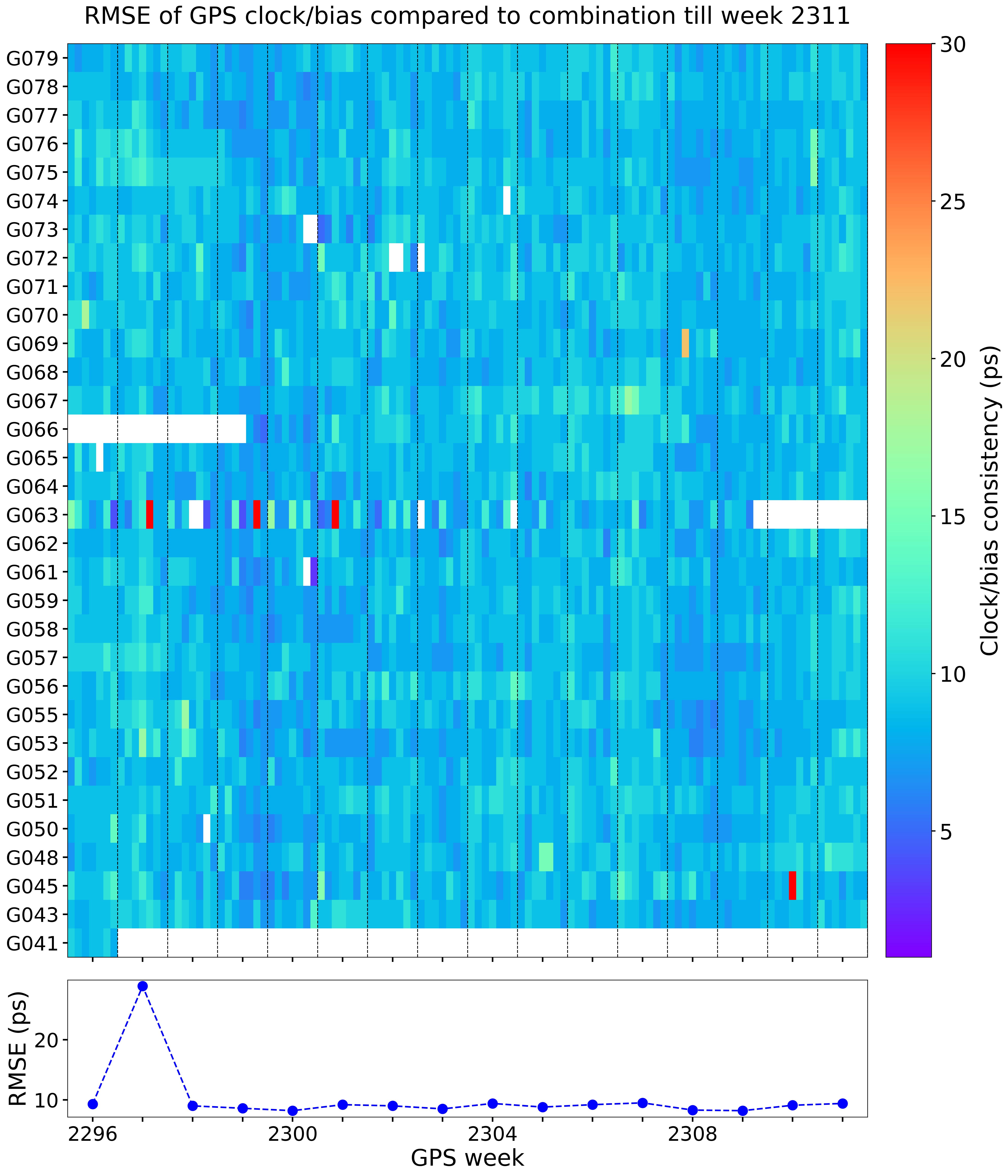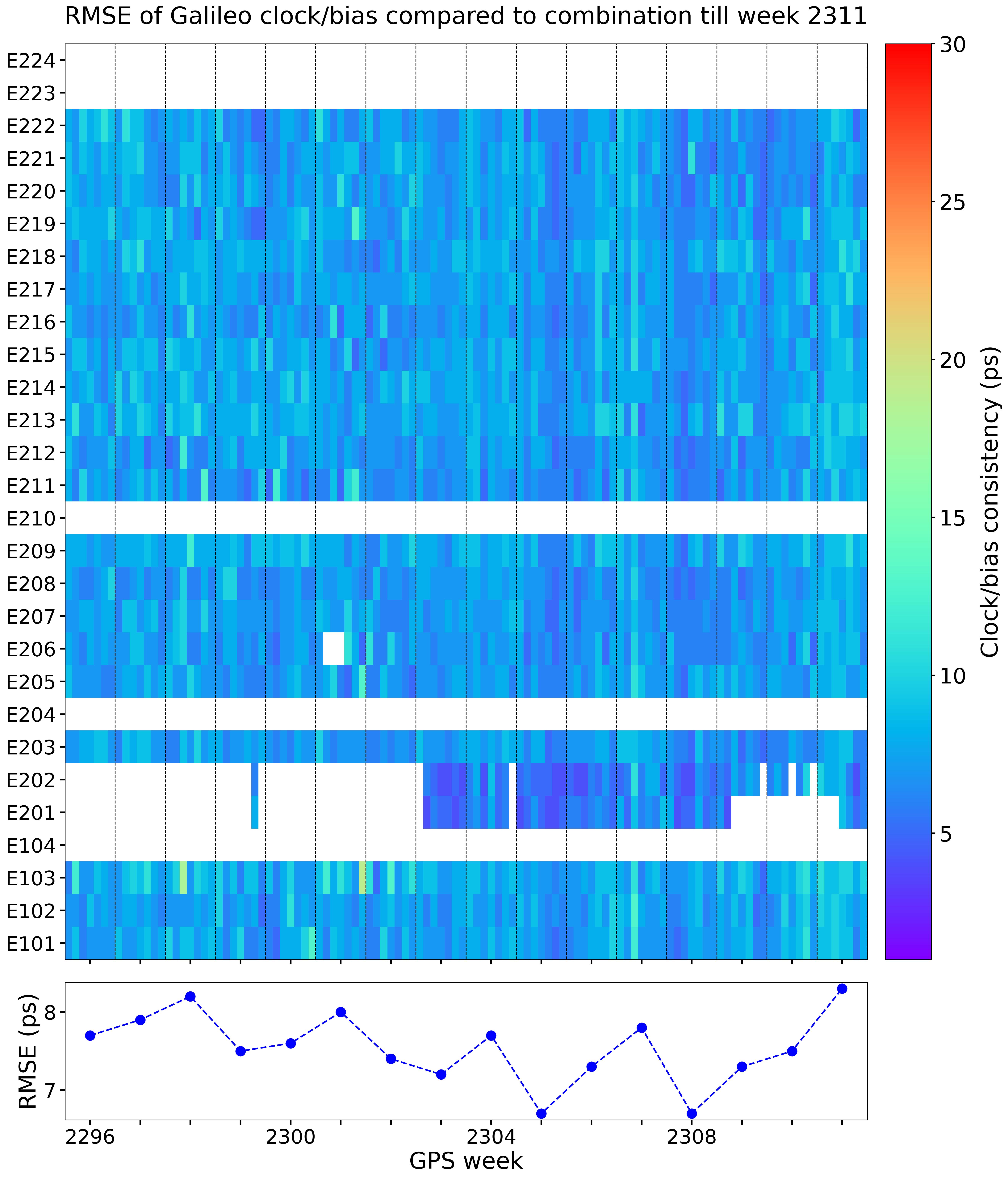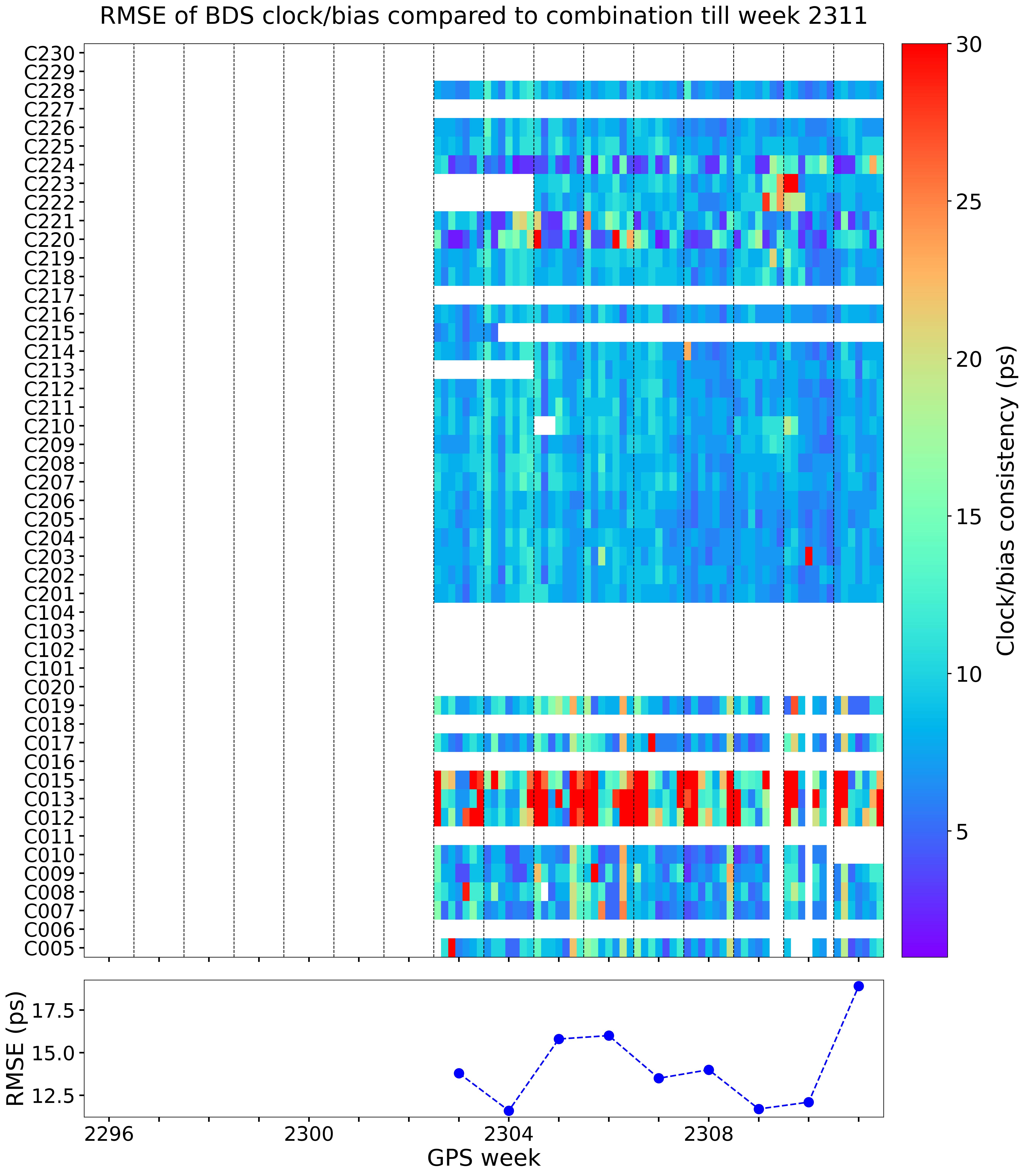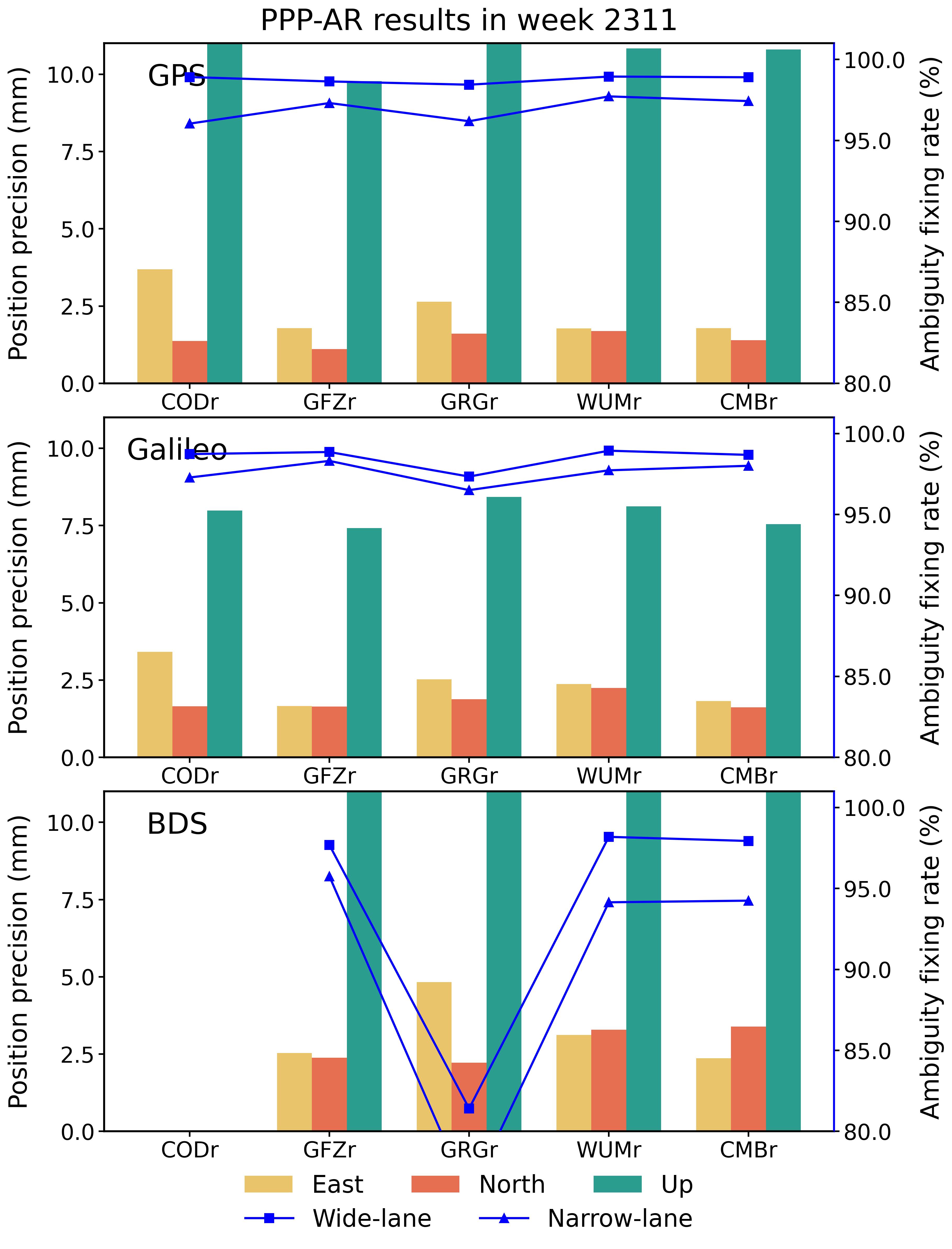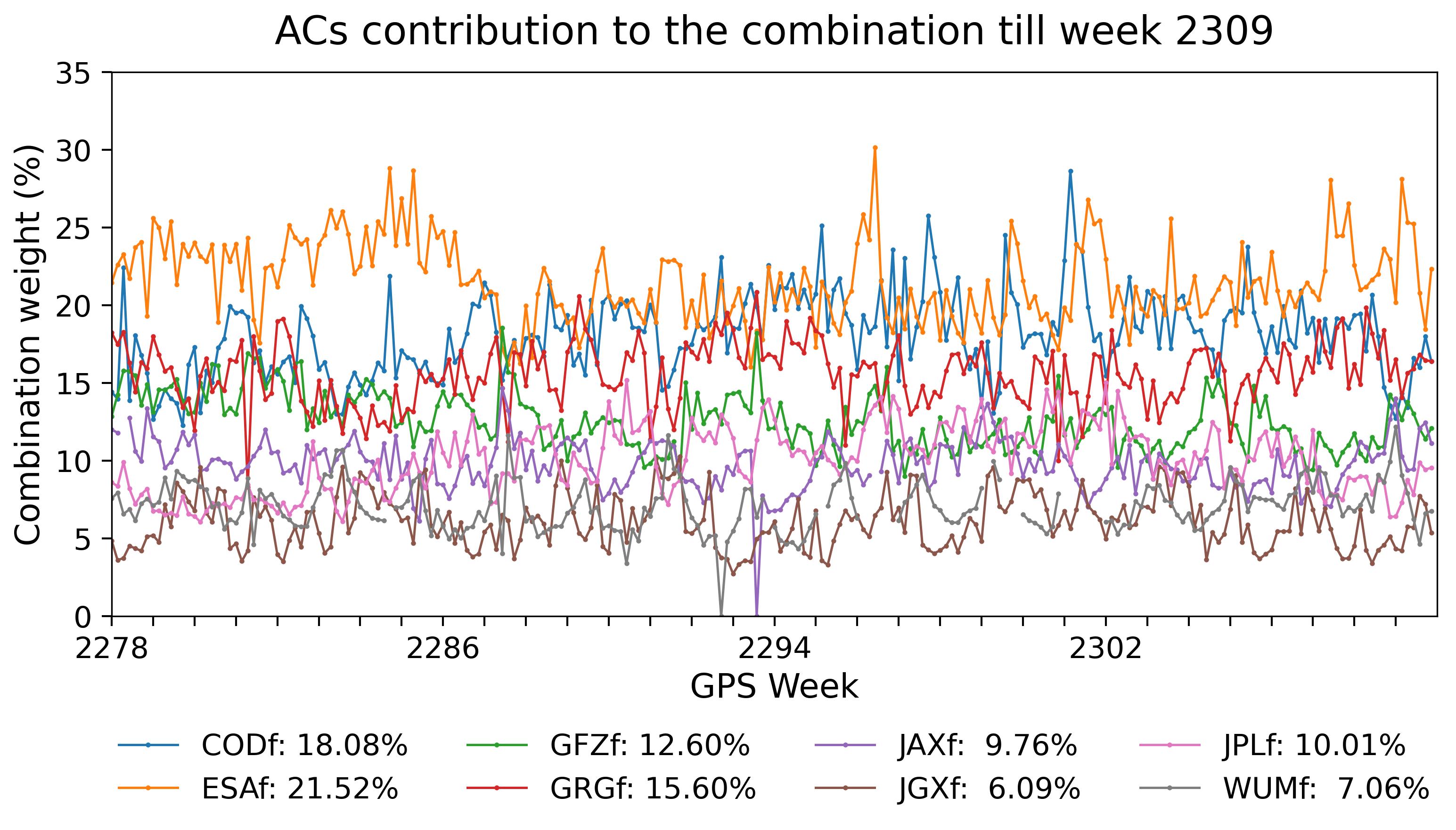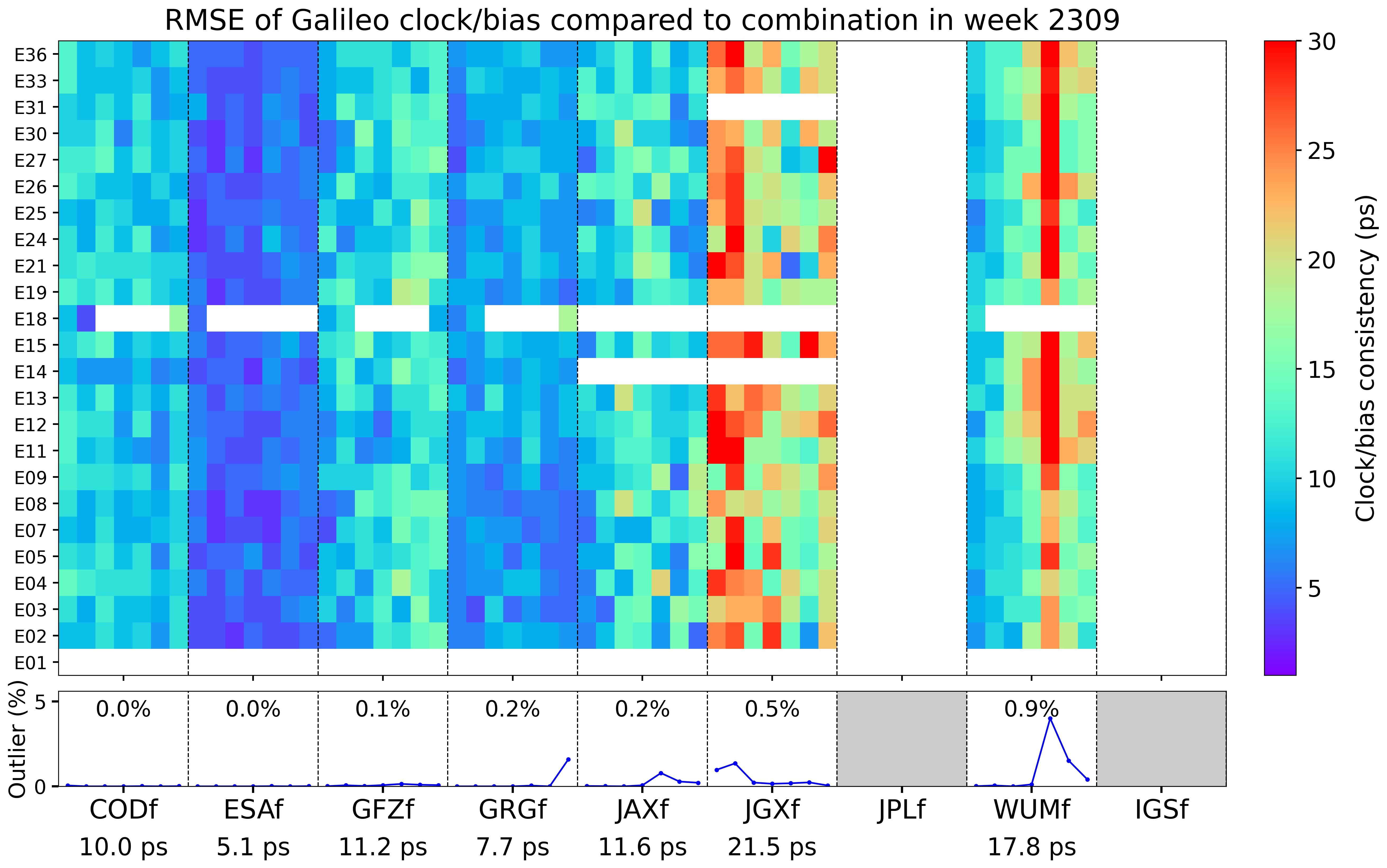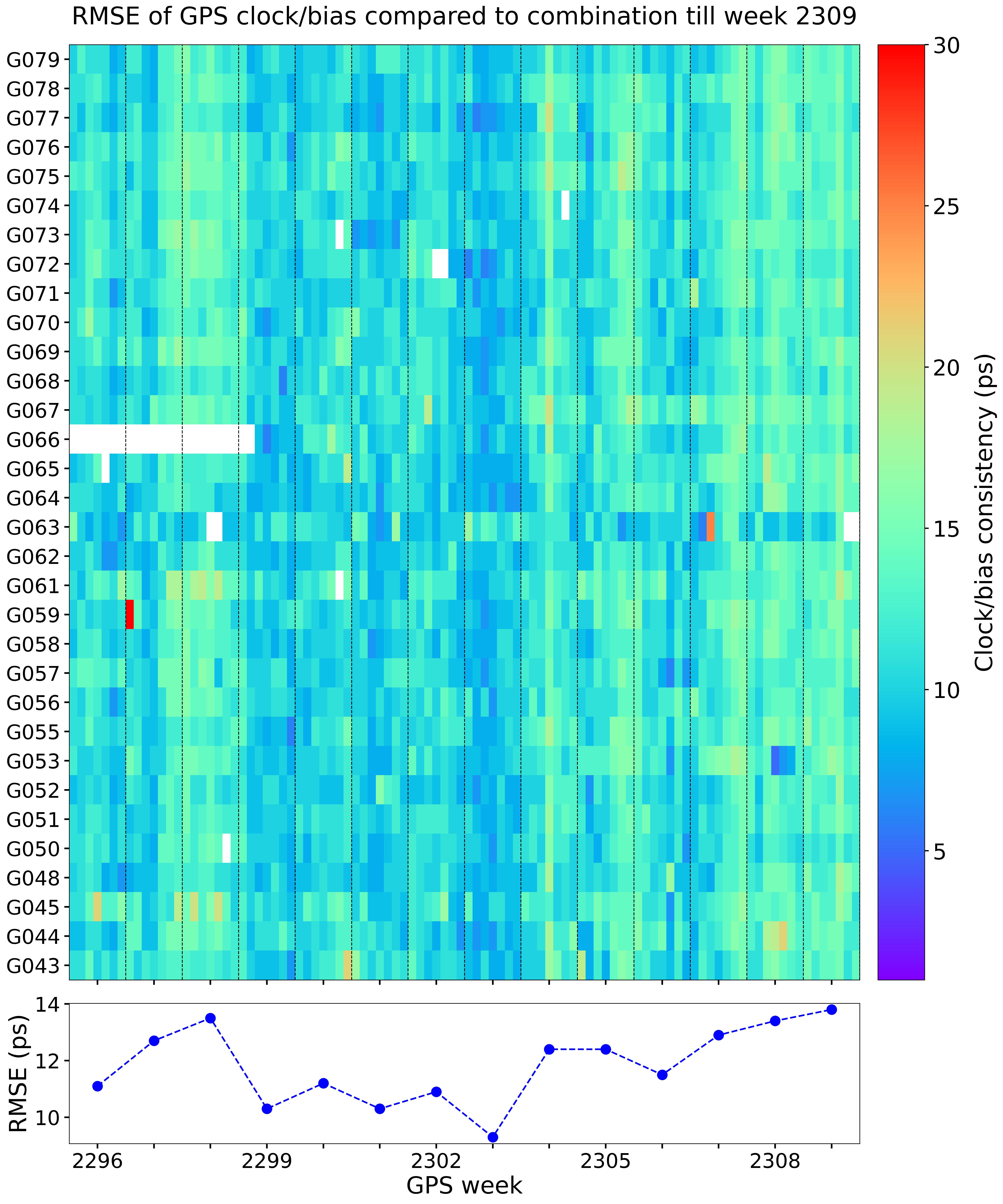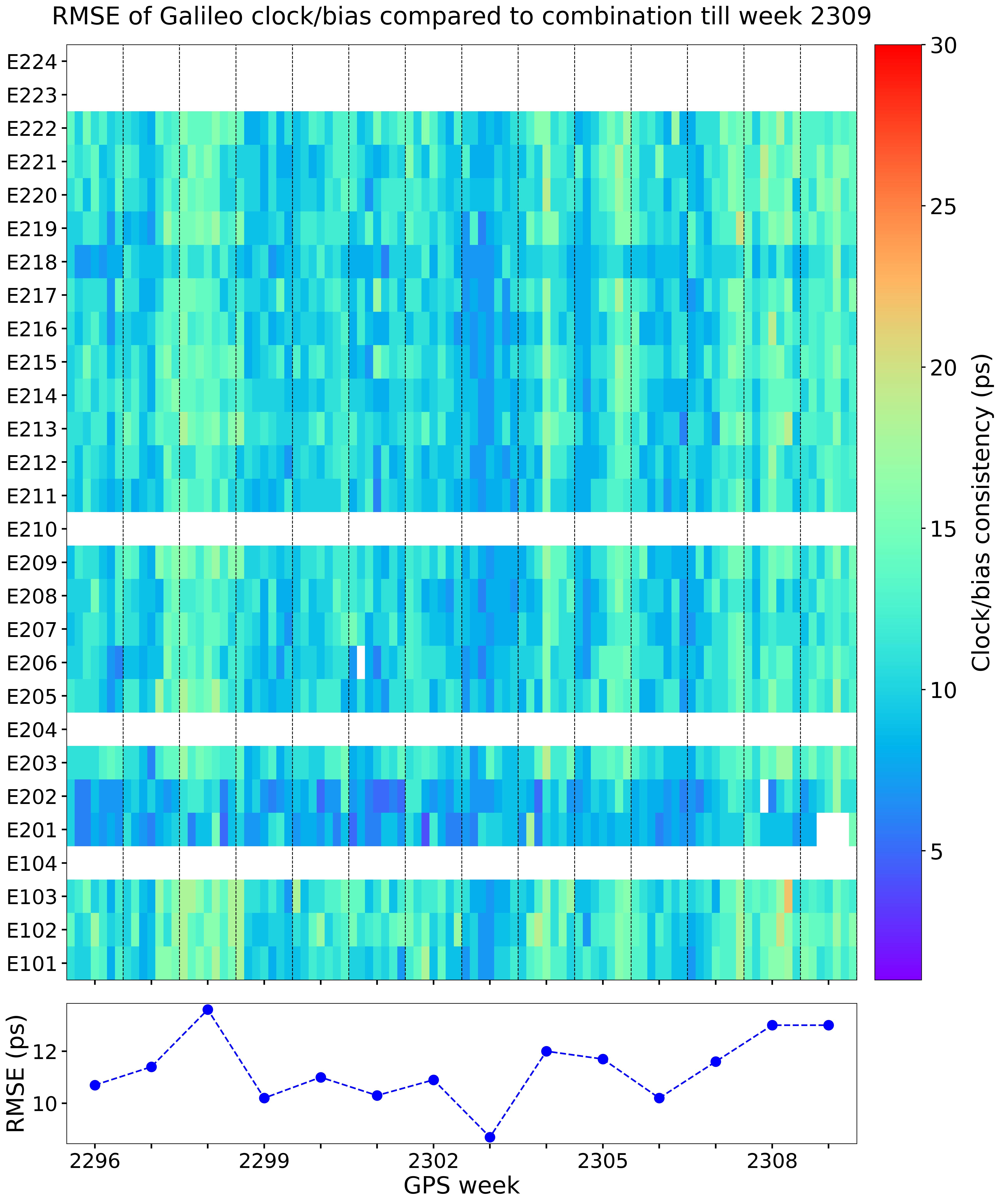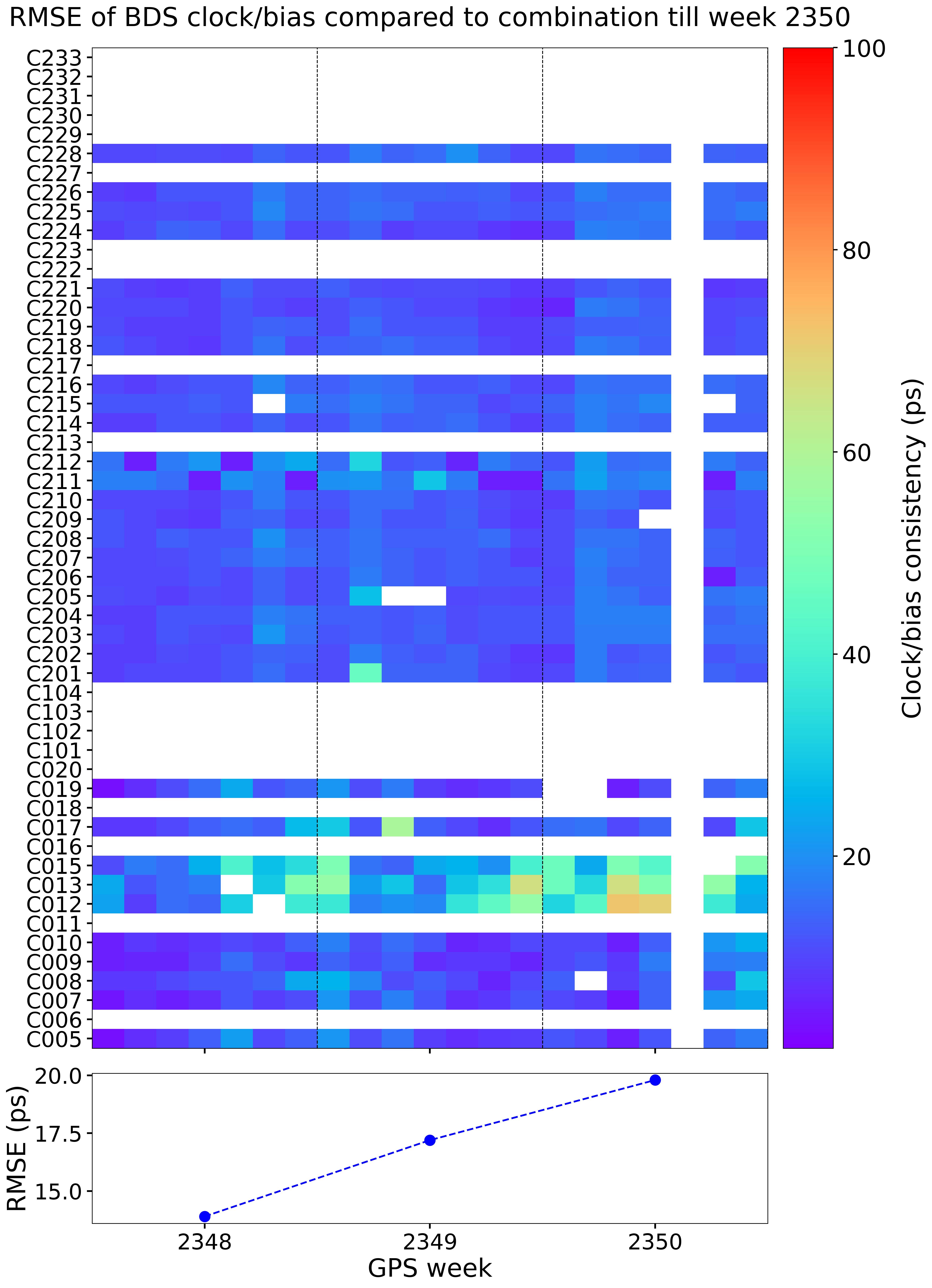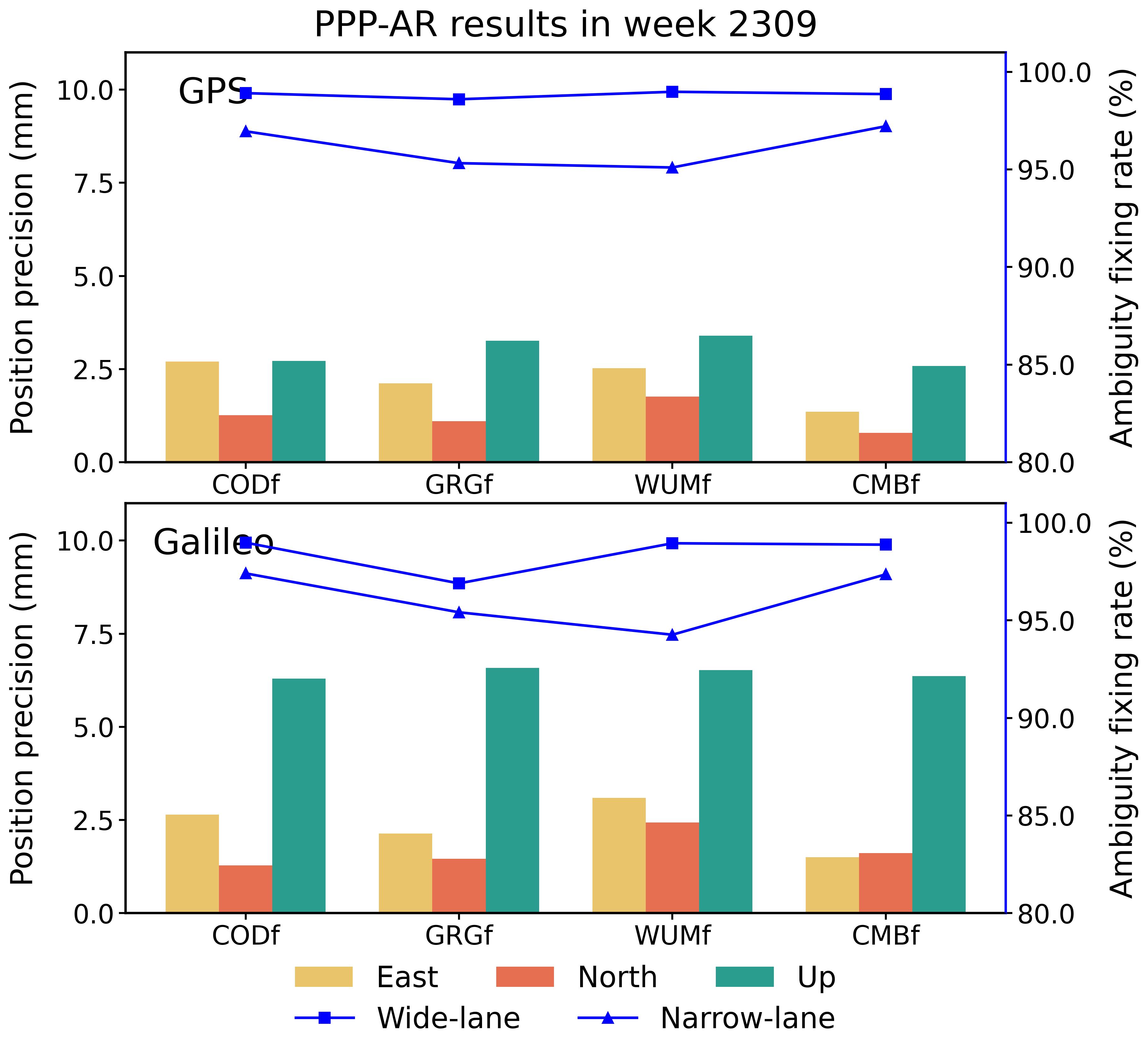Precise Point Positioning with Ambiguity Resolution (PPP-AR) Working Group
Established: 2018
Mailing List: IGS PPP-AR Working Group Mailing List
Charter
Precise point positioning (PPP) is characterized by its undifferenced data processing with predetermined precise satellite products. After resolving undifferenced ambiguities with the aid of code and phase bias products, PPP has the potential to achieve a millimeter-level positioning precision on a global scale, which is consistent with conventional network analysis techniques. Over the past decade, PPP ambiguity resolution (PPP-AR) has been well studied by the GNSS community, and the IGS established the PPP-AR Working Group (WG) in 2018.
The goal of the PPP-AR WG at the first stage is to encourage IGS analysis centers (ACs) to generate phase bias products and further combine them to study their interoperability. At the moment, CODE (Center for Orbit Determination in Europe), GFZ (German Research Center for Geosciences), CNES/CLS (Centre National d’Etudes Spatiales/Collecte Localisation Satellites) and Wuhan University are routinely providing GPS/Galileo phase bias products in the form of observable-specific signal biases (OSBs). Since such code/phase biases are highly correlated with clocks, their cross-validation and combination entail both signal biases and clocks, and an interoperability test has been performed throughout IGS ACs (Banville et al. 2020). In addition, satellite attitudes are also recommended as quaternion products to cope with eclipsing seasons and thus improve the consistency of satellite clocks/biases among ACs (Loyer et al. 2021). In the IGS Repro3, four ACs or institutions (i.e., CODE, CNES/CLS, NRCan, TUGraz) provided OSBs starting from the year of 2000. Their interoperability has been examined and a combined product has been released (Lin et al. 2023). A multi-GNSS satellite phase clock/bias combination software package has also been transferred to the IGS for routine combination tasks.
Based on the achievements above, the goal of the IGS PPP-AR WG for the next stage is to routinely cross-validate each contributing AC’s phase clock/bias products and encourage their continuing efforts in improving phase bias qualities and developing multi-frequency phase clock/bias products.
Goals
Phase 1
- Survey the technical practices and problems from current phase bias estimates.
- Encourage more ACs to produce GPS/Galileo/BDS phase clock/bias products.
- Start a cross-validation task to assess the phase clock/bias qualities and improve the consistency among the contributing products.
- Work with the Bias WG to ensure continuity of clocks/biases at day boundaries by using the integer properties of the combined products.
- Initiate a project to expose the combined clock/bias solution to open testing for the public.
- Develop a phase clock/bias combination software open-sourced across the IGS community.
- Recommend the GB and ACC to introduce a combined clock/bias solution as an official IGS satellite product.
Phase 2
- Work in partnership with the Clock WG on time scale issues associated with continuous “phase” clocks.
- Encourage the RT WG to compute and broadcast real-time phase biases by sharing knowledge on phase bias generation.
- Survey proper models, algorithms, and requirements for multi-frequency phase bias products, and start a pilot project to generate such products.
- Assess the versatility and scalability of multi-frequency phase biases for all conceivable observable combinations and frequency choices, and start a pilot combination task.
Members
The following table contains a list of people who are supporting the PPP-AR WG initiative and willing to contribute products and/or expertise. This list is likely to grow as more people are aware of the WG.
Name |
Institution |
Role |
|---|---|---|
| Jianghui Geng | Wuhan University | Chair |
| Yoaz Bar-Sever | JPL | Analysis center contribution (future) |
| Larry Romans | JPL | Analysis center contribution (future) |
| Ant Sibthorpe | JPL | Analysis center contribution (future) |
| Michael Coleman | NRL | Time alignment advisor |
| Qiyuan Zhang | Wuhan University | Analysis center contribution (MGEX rapid) |
| Jing Guo | Wuhan University | Analysis center contribution (MGEX final) |
| Guo Chen | Wuhan University | Orbit combination |
| Zhe Yan | Wuhan University | Clock/bias combination and web developer |
| Denis Laurichesse | CNES | Analysis center contribution |
| Sylvain Loyer | CLS | Analysis center contribution |
| Benjamin Maennel | GFZ | Analysis center contribution |
| Zhiguo Deng | GFZ | Analysis center contribution |
| Giulio Tagliaferro | BIPM | Clock analysis |
| Francesco Gini | ESA | Analysis center contribution (future) |
| Erik Schoenemann | ESA | Analysis center contribution (future) |
| Nacho Romero | CSC (@ESA/ESOC) | Analysis center contribution (future) |
| Tim Springer | PosiTim (@ESA/ESOC) | Analysis center contribution (future) |
| Stefan Schaer | CODE | Analysis center contribution |
| Baocheng Zhang | CAS | Technical analysis |
| Salim Masoumi | GA | Analysis center coordinator (ACC) |
| Patrick Dumitraschkewitz | TU Graz | Analysis center contribution and reference attitude |
Recommended software for PPP-AR product validation
PRIDE PPP-AR (Precise Point Positioning with Ambiguity Resolution): https://github.com/PrideLab/PRIDE-PPPAR/
Formats
| SINEX Bias | Solution INdependent EXchange format for GNSS biases |
| ORBEX | GNSS attitude quaternions |
Publications related to IGS PPP-AR WG activities
Banville S, Geng J, Loyer S, Schaer S, Springer T, Strasser S (2020) On the interoperability of IGS products for precise point positioning with ambiguity resolution. Journal of Geodesy, 94, 1-15. https://doi.org/10.1007/s00190-019-01335-w
Lin J, Geng J, Yan Z, Masoumi S, Zhang Q (2023) Correcting antenna phase center effects to reconcile the code/phase bias products from the third IGS reprocessing campaign. GPS solutions, 27, 70. https://doi.org/10.1007/s10291-023-01405-9
Loyer S, Banville S, Geng J, Strasser S (2021) Exchanging satellite attitude quaternions for improved GNSS data processing consistency. Advances in Space Research, 68, 2441-2452. https://doi.org/10.1016/j.asr.2021.04.049
Strasser S, Banville S, Kvas A, Loyer S, Mayer-Gürr T (2021) Comparison and generalization of GNSS satellite attitude models. EGU General Assembly. https://doi.org/10.5194/egusphere-egu21-7825
IGSMail related to IGS PPP-AR WG activities
IGS Repro3 orbit. clock, bias and attitude solutions available (IGSMAIL-8248)
A new keyword in Bias-SINEX for antenna phase center corrections on geometry-free biases (IGSMAIL-8279)
Special Issue “GNSS Precise Point Positioning: Towards Global Instantaneous cm-Level Accuracy”
A special issue of Remote Sensing (ISSN 2072-4292).
Deadline for manuscript submissions: 31 December 2021
Precise point positioning (PPP) using global navigation satellite systems (GNSS) enables accurate positioning worldwide. Recent advances, including improved error source modeling and the modernization of GNSS constellations, have reduced the time required to achieve cm-level accuracies from hours to seconds, creating new possibilities for several applications.
The objective of this Special Issue is to address the remaining technical challenges associated with global instantaneous high-accuracy GNSS positioning. Timely and reliable positioning can only be achieved through careful attention to detail in all system components, including space segment, signal propagation medium, and receiver design. Research topics of interest include but are not limited to satellite orbit dynamics (solar radiation pressure, attitude), atmospheric augmentation (functional and stochastic models, contribution of low-Earth orbit (LEO) satellites, correction dissemination), and end-user algorithms (stochastic models, time correlation, ambiguity validation). Since integrity plays a critical role in many emerging applications, novel network and end-user techniques for improved error source characterization are also of interest.
I hope that by focusing our efforts on these technical challenges, end-users in a wide range of applications including autonomous vehicles, marine navigation, and many more, can experience fast and accurate positioning globally
For more information: https://www.mdpi.com/journal/remotesensing/special_issues/GNSS_PPP
Centre National d’Etudes Spatiales (CNES) / Navigation Team
Product Line |
Bias SINEX |
Phase Biases |
Start Date |
End Date |
Sampling Rate |
Link |
|---|---|---|---|---|---|---|
| Rapid | Yes | GPS L1/L2/L5 | 2019-001 | 30 S | http://www.ppp-wizard.net/products/POST_PROCESSED/ | |
| Galileo L1/L5/L6/L7 | ||||||
| BDS-2 L2/L6/L7 | ||||||
| BDS-3 L1/L2/L5/L6/L7 | ||||||
| Real time | Yes | GPS L1/L2/L5 | 2019-001 | 30 S | http://www.ppp-wizard.net/products/REAL_TIME/ | |
| Galileo L1/L5/L6/L7 | ||||||
| BDS-2 L2/L6/L7 | ||||||
| BDS-3 L2/L6/L7 |
Center for Orbit Determination in Europe (CODE) [COD]
Product Line |
Bias SINEX |
Phase Biases |
Start Date |
End Date |
Sampling Rate |
Link |
|---|---|---|---|---|---|---|
| Rapid | Yes | GPS L1/L2 | 2019-001 | 1 D | http://ftp.aiub.unibe.ch/CODE/yyyy_M/ https://cddis.nasa.gov/archive/gnss/products/wwww/ |
|
| Galileo L1/L5 | 2019-272 | 1 D | ||||
| Final | Yes | GPS L1/L2 | 2019-001 | 1 D | http://ftp.aiub.unibe.ch/CODE/yyyy/ https://cddis.nasa.gov/archive/gnss/products/wwww/ |
|
| Galileo L1/L5 | 2019-272 | 1 D | ||||
| MGEX | Yes | GPS L1/L2 | 2018-182 | 1 D | http://ftp.aiub.unibe.ch/CODE_MGEX/CODE/yyyy/ https://cddis.nasa.gov/archive/gnss/products/wwww/ |
|
| Galileo L1/L5 | ||||||
| QZSS L1/L2 | 2024-126 | 1 D | ||||
| Repro3 | Yes | GPS L1/L2 | 2000-124 | 2022-330 | 1 D | http://ftp.aiub.unibe.ch/REPRO_2020/CODE/yyyy/ https://cddis.nasa.gov/archive/gnss/products/wwww/repro3/ |
| Galileo L1/L5 | 2014-001 | 2022-330 | 1 D |
Natural Resources Canada (NRCan) [EMR]
Product Line |
Bias SINEX |
Phase Biases |
Start Date |
End Date |
Sampling Rate |
Link |
|---|---|---|---|---|---|---|
| Repro3 | Yes | GPS L1/L2 | 2000-001 | 2020-366 | 1 D | https://cddis.nasa.gov/archive/gnss/products/wwww/repro3/ |
German Research Center for Geosciences (GFZ) [GFZ]
Product Line |
Bias SINEX |
Phase Biases |
Start Date |
End Date |
Sampling Rate |
Link |
|---|---|---|---|---|---|---|
| MGEX | No | GPS WL L1/L2 | 2021-167 | 2021-189 | 1 D | ftp://ftp.gfz-potsdam.de/pub/GNSS/products/mgex/wwww/ |
| Galileo WL L1/L5 | ||||||
| BDS-2 WL L2/L6 | ||||||
| BDS-3 WL L2/L6 | ||||||
| Yes | GPS L1/L2 | 2021-190 | 1 D | https://cddis.nasa.gov/archive/gnss/products/wwww/ | ||
| Galileo L1/L5 | ||||||
| BDS-2 L2/L6 | ||||||
| BDS-3 L2/L6 |
Centre National d’Etudes Spatiales (CNES) / Collecte Localisation Satellites (CLS) [GRG]
Huazhong University of Science and Technology [HUS]
Product Line |
Bias SINEX |
Phase Biases |
Start Date |
End Date |
Sampling Rate |
Link |
|---|---|---|---|---|---|---|
| MGEX (Rapid) | Yes | GPS L1/L2 | 2024-286 | 1 D | ftp://ggda.ac.cn/pub/mgex/products/yyyy | |
| Galileo L1/L5 | ||||||
| BDS-2 L2/L6 | ||||||
| BDS-3 L2/L6 | ||||||
| MGEX (Final) | Yes | GPS L1/L2 | 2024-284 | 1 D | ftp://ggda.ac.cn/pub/mgex/products/yyyy | |
| Galileo L1/L5 | ||||||
| BDS-2 L2/L6 | ||||||
| BDS-3 L2/L6 |
Graz University of Technology [TUG]
Product Line |
Bias SINEX |
Phase Biases |
Start Date |
End Date |
Sampling Rate |
Link |
|---|---|---|---|---|---|---|
| Repro3 | Yes | GPS L1/L2 | 1994-001 | 2020-366 | 1 D | https://cddis.nasa.gov/archive/gnss/products/wwww/repro3/ |
| GPS L5 | 2010-240 | 2020-366 | 1 D | |||
| Galileo L1/L5/L7/L8 | 2013-001 | 2020-366 | 1 D |
Wuhan University [WUM]
Product Line |
Bias SINEX |
Phase Biases |
Start Date |
End Date |
Sampling Rate |
Link |
|---|---|---|---|---|---|---|
| MGEX (Rapid) | Yes | GPS L1/L2 | 2020-001 | 2022-365 | 1 D | ftp://igs.gnsswhu.cn/pub/whu/phasebias/ |
| Galileo L1/L5 | ||||||
| BDS-2 L2/L6 | ||||||
| BDS-3 L2/L6 | ||||||
| Yes | GPS L1/L2/L5 | 2023-001 | 1 D | |||
| Galileo L1/L5/L6/L7/L8 | ||||||
| BDS-2 L2/L6/L7 | ||||||
| BDS-3 L1/L2/L5/L6/L7 | ||||||
| MGEX (Final) | Yes | GPS L1/L2 | 2023-163 | 1 D | https://cddis.nasa.gov/archive/gnss/products/wwww/ | |
| Galileo L1/L5 | ||||||
| BDS-2 L2/L6 | ||||||
| BDS-3 L2/L6 | ||||||
| Real time | Yes | GPS L1/L2/L5 | 2023-329 | 300 S | ftp://igs.gnsswhu.cn/pub/whu/phasebias/ ntrip.gnsslab.cn:2101, OSBC00WHU1 |
|
| Galileo L1/L5/L6/L7/L8 | ||||||
| BDS-2 L2/L6/L7 | ||||||
| BDS-3 L1/L2/L5/L6/L7 |
2021-09-16
Meeting to discuss the impact of phase center offsets on bias computation.
Summary: PPPAR-WG_20210916_Summary.pdf
Presentation: PPPAR-WG_20210916_Presentation1.pdf
2022-06-30—2022-08-16
Email communications to discuss a new keyword in Bias-SINEX denoting APC corrections.
IGS Mail announcement: IGSMAIL-8279
2023-11-14
Virtual meeting to discuss a new charter and the webpages showing the combination results, etc.
Summary: PPPAR-WG_20231114_Summary.pdf
Presentation: PPPAR-WG_20231114_Presentation.pdf
2024-11-27
Virtual meeting to discuss some technical issues related to the quality, consistency of current PPP-AR products, as well as the one-year routine PPP-AR combination results.
Summary: PPPAR-WG_20241127_Summary.pdf
Presentation:
PPPAR-WG_20241127_Presentation.pdf
One-year routine PPP-AR combination results.pdf
Combination and analysis of rapid products
The rapid clock and phase bias products provided by different ACs are combined and evaluated.
These products are accessed from the CDDIS archive (https://cddis.nasa.gov/archive/gnss/products/) and the corresponding ACs are listed in the following table. Currently this combination and analysis are only applied to the GPS, Galileo and BDS since the phase bias products provided by ACs are available for these constellations. And other systems are not included in the analysis at this stage.
ID |
Rapid | |||||||||
|---|---|---|---|---|---|---|---|---|---|---|
| name | system | orbit | clock | attitude | code bias | phase bias | APC model | |||
| COD | COD0OPSRAP | GE | 300 s | 30 s | 30 s | GE (OSB) | GE (OSB) | applied | ||
| EMR | EMR0OPSRAP | G | 900 s | 300 s | ||||||
| ESA | ESA0OPSRAP | G | 300 s | 30 s | ||||||
| GFZ | GFZ0MGXRAP | GEC | 300 s | 30 s | 30 s | GEC (OSB) | GEC (OSB) | applied | ||
| GRG | GRG0OPSRAP | GEC | 300 s | 30 s | 30 s | GEC (OSB) | GEC (OSB) | applied | ||
| HUS | HUS0MGXRAP | GEC | 300 s | 30 s | 30 s | GEC (OSB) | GEC (OSB) | applied | ||
| IGS | IGS0OPSRAP | G | 900 s | 300 s | ||||||
| JGX | JGX0OPSRAP | GE | 300 s | 30 s | ||||||
| JPL | JPL0OPSRAP | GE | 300 s | 30 s | 30 s | |||||
| USN | USN0OPSRAP | G | 900 s | 300 s | ||||||
| WUM | WUM0MGXRAP | GEC | 300 s | 30 s | 30 s | GEC (OSB) | GEC (OSB) | applied | ||
| Note: a. In the combination and analysis, rapid products from AC are represented using their ID + “r”, e.g. “CODr” is for the rapid products from COD. b. GEC stand for GPS, Galileo and BDS-2/3 respectively. c. OSB stands for observable specific bias, IRC stands for integer recovery clock. |
||||||||||
Evaluation of combined results
For the methods used in the clock and bias combination, please refer to the tabs Resources.
All the products in the table are included in the combination except for the IGS products, which is used for comparison. The reference orbit products are generated from the Wuhan University and the reference attitude is generated by the open source software GROOPS. The GNSS rapid clock products are combined with a sampling interval of 30 s. All the results are presented on a weekly basis, with a latency of one week.
The combined weight
The clock combination employs an iterative weighting method in which the weight assigned to a specific product depends on its residuals in relation to the combined clock.
The weekly clock/bias RMSE
The clock/bias RMSE refers to the daily RMSE of clock/bias for each AC with respect to the combined integer clock, which reflects the precision of clock and bias combination and the consistency between individual ACs. Each grid represents a satellite on a particular day. Blank grids mean unavailable products and a slash inside means an outlier excluded from the combination. The line chart below shows the satellite clock outlier rate per day for each AC, with gray block indicating that relevant satellite clocks do not participate in the comparison. The statistics at the bottom indicate the overall RMSE of AC clock/bias for this week.
The accumulated clock/bias RMSE
The accumulated clock/bias RMSE refers to the daily RMSE of clock/bias for all the ACs with respect to the combined integer clock, which reflects the change of the combined accuracy over time. The line chart below shows the overall RMSE for each constellation.
PPP-AR validation
The GPS/Galileo/BDS data with a sampling interval of 300 s from 10 globally distributed stations are processed for PPP-AR in a static mode with the PRIDE PPP-AR software. The fixing rate and position precision of each single constellation solution are presented in the figure below. IGS daily SINEX products are used as reference solution. “CMBr” stands for the combined rapid products.
Combination and analysis of final products
The final clock and phase bias products provided by different ACs are combined and evaluated.
These products are accessed from the CDDIS archive (https://cddis.nasa.gov/archive/gnss/products/) and the corresponding ACs are listed in the following table. Currently this combination and analysis are only applied to the GPS, Galileo and BDS since the phase bias products provided by ACs are available for these constellations. And other systems are not included in the analysis at this stage.
ID |
Final | |||||||||
|---|---|---|---|---|---|---|---|---|---|---|
| name | system | orbit | clock | attitude | code bias | phase bias | APC model | |||
| COD | COD0OPSFIN | GE | 300 s | 30 s | 30 s | GE (OSB) | GE (OSB) | applied | ||
| ESA | ESA0OPSFIN | GEC | 300 s | 30 s | ||||||
| GFZ | GFZ0OPSFIN | GE | 300 s | 30 s | ||||||
| GRG | GRG0MGXFIN | GEC | 300 s | 30 s | 30 s | GEC (OSB) | GEC (OSB) | applied | ||
| HUS | HUS0MGXFIN | GEC | 300 s | 30 s | 30 s | GEC (OSB) | GEC (OSB) | applied | ||
| IGS | IGS0OPSFIN | G | 900 s | 30 s | ||||||
| JAX | JAX0MGXFIN | GE | 300 s | 30 s | ||||||
| JGX | JGX0OPSFIN | GE | 300 s | 30 s | ||||||
| JPL | JPL0OPSFIN | GE | 300 s | 30 s | 30 s | |||||
| WUM | WUM0MGXFIN | GEC | 300 s | 30 s | 30 s | GEC (OSB) | GEC (OSB) | applied | ||
| Note: a. In the combination and analysis, final products from AC are represented using their ID + “f”, e.g., “CODf” is for the final products from COD. b. GEC stand for GPS, Galileo and BDS-2/3 respectively. c. OSB stands for observable specific bias, IRC stands for integer recovery clock. |
||||||||||
Evaluation of combined results
For the methods used in the clock and bias combination, please refer to the tabs Resources.
All the products in the table are included in the combination except for the IGS products, which is used for comparison. The reference orbit products are generated from the Wuhan University and the reference attitude is generated by the open source software GROOPS. The GNSS final clock products are combined with a sampling interval of 30 s. All the results are presented on a weekly basis, with a latency of three weeks.
The combined weight
The clock combination employs an iterative weighting method in which the weight assigned to a specific product depends on its residuals in relation to the combined clock.
The weekly clock/bias RMSE
The clock/bias RMSE refers to the daily RMSE of clock/bias for each AC with respect to the combined integer clock, which reflects the precision of clock and bias combination and the consistency between individual ACs. Each grid represents a satellite on a particular day. Blank grids mean unavailable products and a slash inside means an outlier excluded from the combination. The line chart below shows the satellite clock outlier rate per day for each AC, with gray block indicating that relevant satellite clocks do not participate in the comparison. The statistics at the bottom indicate the overall RMSE of AC clock/bias for this week.
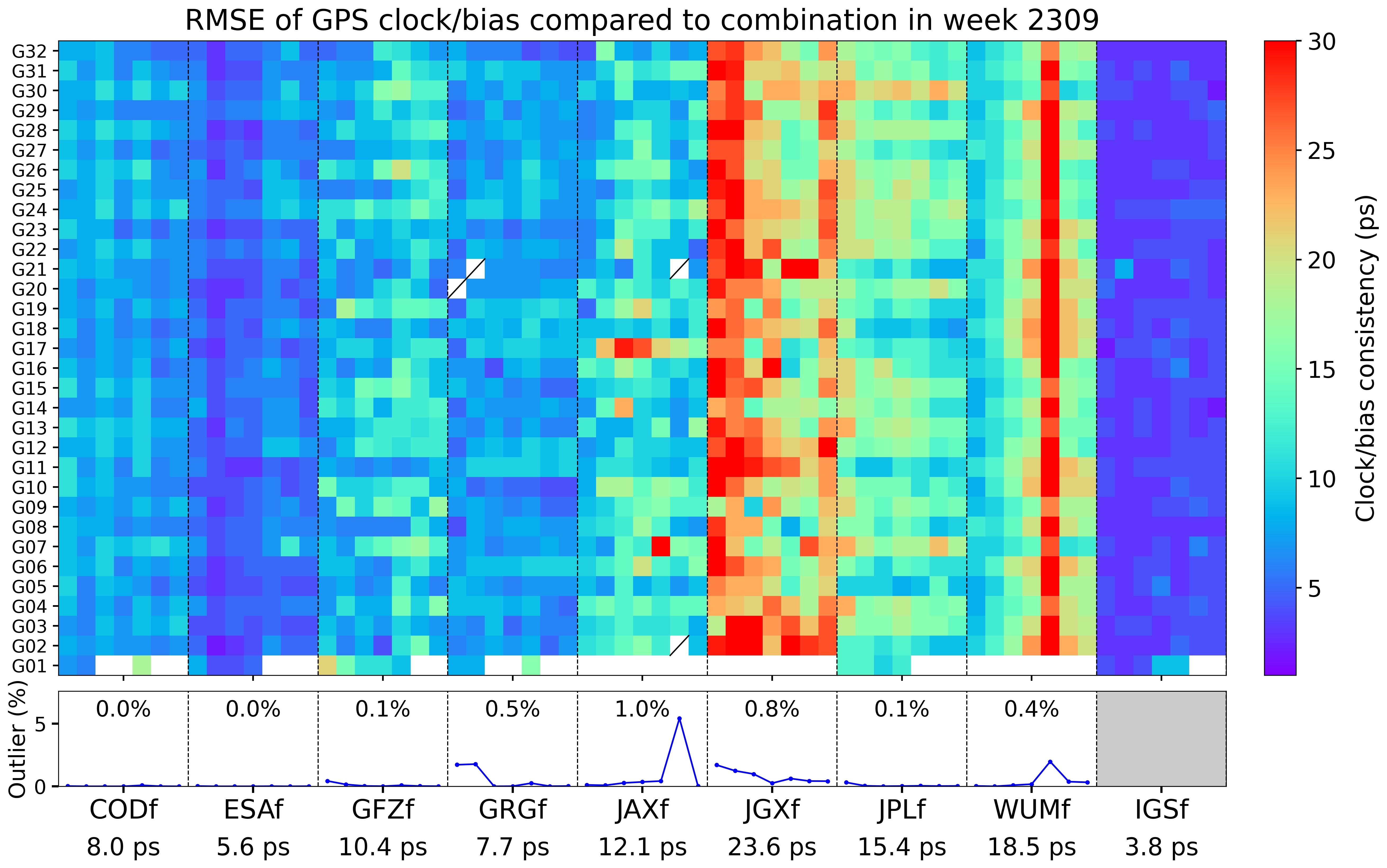
The accumulated clock/bias RMSE
The accumulated clock/bias RMSE refers to the daily RMSE of clock/bias series for all the ACs with respect to the combined integer clock, which reflects the change of the combined accuracy over time. The line chart below shows the overall RMSE for each constellation.
PPP-AR validation
The GPS/Galileo/BDS data with a sampling interval of 300 s from 10 globally distributed stations are processed for PPP-AR in a static mode with the PRIDE PPP-AR software. The fixing rate and position precision of each single constellation solution are presented in the figure below. IGS daily SINEX products are used as reference solution. “CMBf” stands for the combined final products.
Last Updated on 5 Nov 2025 02:00 UTC




